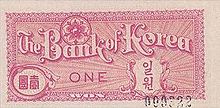South Korean hwan
| South Korean hwan | |
|---|---|
|
대한민국 환 (Korean) 大韓民國圜 (Hanja) |
|
| Denominations | |
| Subunit | |
| 1/100 | jeon (전/錢) Never used |
| Plural | The language(s) of this currency does not have a morphological plural distinction. |
| Banknotes | 1, 5, 10, 50, 100, 500, 1000 hwan |
| Coins | 10, 50, 100 hwan |
| Demographics | |
| User(s) | Republic of Korea |
| Issuance | |
| Central bank | Bank of Korea |
| Website | www.bok.or.kr |
| Printer | Korea Minting and Security Printing Corporation |
| Website | http://english.komsco.com/ |
| Mint | Philadelphia Mint |
|
This infobox shows the latest status before this currency was rendered obsolete.
|
|
| South Korean hwan | |

1 hwan note
|
|
| Hangul | 환 |
|---|---|
| Hanja | 圜 |
| Revised Romanization | hwan |
| McCune–Reischauer | hwan |
The hwan was the currency of the Republic of Korea (South Korea) between February 15, 1953 and June 9, 1962.
Due to the devaluation of the first South Korean won (from 15 won to the U.S. dollar in 1945 to 6000 won to the dollar in 1953), the hwan was introduced in 1953 at the rate of 1 hwan = 100 won. The hwan was nominally subdivided into 100 jeon but the lowest denomination issued was 1 hwan. The hwan also suffered from inflation and a series of devaluations occurred.
In 1962, the second South Korean won was reintroduced at a rate of 1 won = 10 hwan, after which inflation finally slowed down.
In 1959, coins were introduced in denominations of 10, 50 and 100 hwan. They were minted by the Philadelphia Mint.
The 10 and 50 hwan coins continued to circulate until March 22, 1975 but the 100 hwan coins were withdrawn on June 10, 1962.
In 1953, banknotes were introduced in denominations of 1, 5, 10, 100 and 1000 hwan. Some of these notes were printed in the U.S. and gave the denomination in English and Hangul as won. 500 hwan notes were introduced in 1956, followed by 1000 hwan in 1957 and 50 hwan in 1958.
The first hwan notes were printed by the United States Government Printing Office. All Hanja and Hangul inscription on both the obverse and reverse sides of these notes are written right to left (traditional direction), instead of the modern (Westernized) left to right.
They have a few obvious defects. The term "hwan" is written in Hanja (圜) while "won" is written in Hangul (원) and English. Those problems were attributed to an urgent need for new banknotes and the change in currency name, as well as the decision to commission the new notes to be manufactured in the United States. Unaware banknote catalog editors may erroneously categorize these notes as part of the old won system, such as the Standard Catalog of World Paper Money by Albert Pick.
...
Wikipedia
